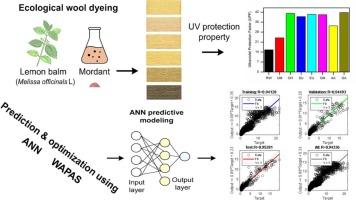天然染色系统的预测建模和化学计量学优化:以羊毛染色为例
IF 4.9
2区 化学
Q1 CHEMISTRY, ANALYTICAL
引用次数: 0
摘要
本研究引入了一个强大的化学计量学框架,该框架集成了预测建模和多标准决策,用于天然染料系统的分析评估。以梅莉莎(Melissa officinalis L.)为模型提取物,通过客观比色参数对羊毛纱线的生态染色应用进行了评价。共评估了40种涉及生物和金属媒染剂的治疗组合。采用加权总和产品评价(WASPAS)方法,根据L*、a*和b*的值对处理进行排序,确定Cu-GA组合为最优,综合得分为1.71。为了模拟染色行为,我们实现了一个前馈人工神经网络(ANN),该网络在处理和波长条件下训练了3720 K/S数据点。利用Levenberg-Marquardt反向传播,ANN获得了较高的预测准确率(R2 = 94.13-95.28, MSE = 1.37-1.95)。该模型可以对未测量的颜色强度值进行插值,提高了再现性,减少了实验负荷。紫外线防护也进行了评估,Cu-GA处理的最大UPF为128.43。染料发色团和纤维之间的配位键解释了铁和铜介质样品的耐洗、耐摩擦和耐光性增强。这些结果展示了机器学习和决策科学工具如何在染料系统中推广分析预测。集成的ANN-WASPAS框架提供了一种可转移的分析策略,适用于更广泛的天然产品配方,质量控制和可持续材料研究。本文章由计算机程序翻译,如有差异,请以英文原文为准。

Predictive modeling and chemometric optimization in natural dyeing systems: An analytical case study of wool dyeing with Melissa officinalis L
This study introduces a robust chemometric framework that integrates predictive modeling and multi-criteria decision-making for the analytical assessment of natural dye systems. Using Melissa officinalis L. as a model extract, we demonstrate an eco-conscious dyeing application on wool yarns evaluated through objective colorimetric parameters. A total of 40 treatment combinations involving bio- and metal mordants were assessed. The Weighted Aggregated Sum Product Assessment (WASPAS) method was used to rank treatments based on L*, a*, and b* values, identifying the Cu-GA combination as optimal with a composite score of 1.71. To model dyeing behavior, we implemented a feedforward Artificial Neural Network (ANN) trained on 3720 K/S data points across treatment and wavelength conditions. The ANN achieved high predictive accuracy (R2 = 94.13–95.28; MSE = 1.37–1.95) using Levenberg–Marquardt backpropagation. This model enabled the interpolation of unmeasured color strength values, enhancing reproducibility and reducing experimental load. UV protection was also evaluated, with the Cu-GA treatment achieving a maximum UPF of 128.43. Enhanced wash, rub, and light fastness in Fe and Cu mordanted samples were explained via coordination bonding between dye chromophores and fiber. These results demonstrate how machine learning and decision science tools can generalize analytical predictions in dye systems. The integrated ANN–WASPAS framework offers a transferable analytical strategy applicable to broader natural product formulations, quality control, and sustainable materials research.
求助全文
通过发布文献求助,成功后即可免费获取论文全文。
去求助
来源期刊

Microchemical Journal
化学-分析化学
CiteScore
8.70
自引率
8.30%
发文量
1131
审稿时长
1.9 months
期刊介绍:
The Microchemical Journal is a peer reviewed journal devoted to all aspects and phases of analytical chemistry and chemical analysis. The Microchemical Journal publishes articles which are at the forefront of modern analytical chemistry and cover innovations in the techniques to the finest possible limits. This includes fundamental aspects, instrumentation, new developments, innovative and novel methods and applications including environmental and clinical field.
Traditional classical analytical methods such as spectrophotometry and titrimetry as well as established instrumentation methods such as flame and graphite furnace atomic absorption spectrometry, gas chromatography, and modified glassy or carbon electrode electrochemical methods will be considered, provided they show significant improvements and novelty compared to the established methods.
 求助内容:
求助内容: 应助结果提醒方式:
应助结果提醒方式:


